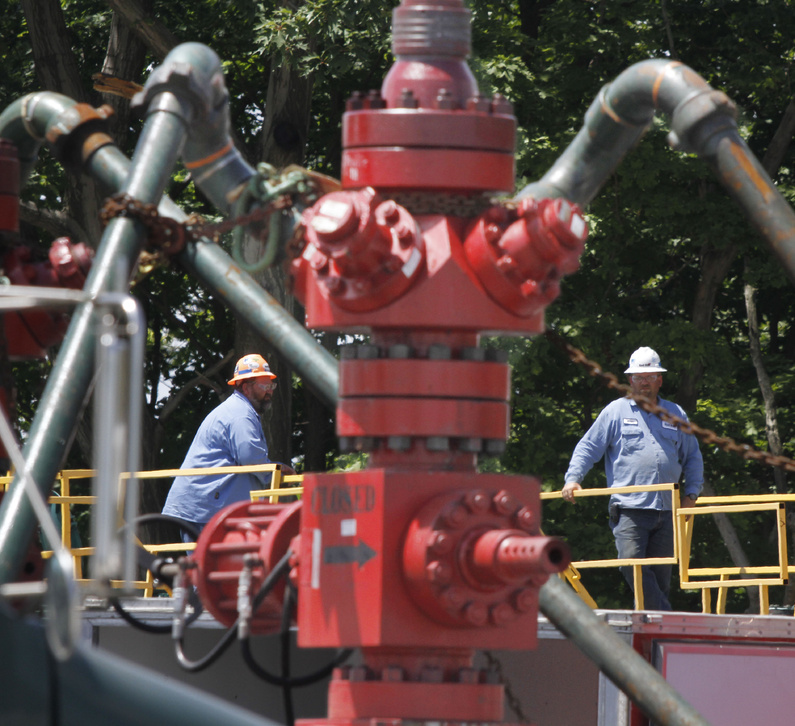TOWANDA, Pa. — Ever since Richard Nixon’s 1973 promise to attain energy independence, successive U.S. presidents all have pledged the same goal, even as foreign supplies composed a larger and larger share of the U.S. energy mix.
Now, almost 40 years later, a measure of independence is within reach. But as this booming mountain town in northeastern Pennsylvania shows, the quest for independence involves both opportunities and trade-offs.
It may surprise Americans who’ve lived through many years of dependence on foreign fuels, but in less than a decade the United States could pass its 1970s peak as an oil and natural gas producer. If that happens – and many analysts think it’s possible – the United States would edge past Saudi Arabia and Russia to become the world’s top energy producer.
That alone wouldn’t make us completely energy independent. Mexico and Canada are likely to remain stable providers of oil to supplement growing U.S. production. And other factors will help too, ranging from advances in battery technologies and alternative fuels such as ethanol to greater fuel economy in automobiles.
However, the biggest potential game changer for U.S. energy production is natural gas, which previously had been supplied largely from the Gulf of Mexico region. Just a few years ago, terminals were being built at U.S. ports in anticipation of importing natural gas; today, there’s talk of exporting it.
Technological advances have allowed drillers to go down almost 7,000 feet, smashing through rock formations and drilling horizontally, freeing trapped oil and gas that long had been considered inaccessible.
“Shale gas, the biggest energy innovation since the start of the new century, has turned what was an imminent shortage in the United States into what may be a hundred-year supply and may do the same elsewhere in the world,” Daniel Yergin, the world’s most prominent oil historian, wrote in his new book about energy security, “The Quest.”
The promise of shale gas is present in many places that are being developed across the country, but it’s nowhere more visible than in northeastern Pennsylvania’s Bradford County, which is in the aptly named Endless Mountains region. Communities here sit atop the Marcellus Shale formation, which runs along southern New York state through western Pennsylvania into eastern Ohio and parts of Maryland and West Virginia.
Geologists think the Marcellus Shale formation contains the second-largest natural gas deposits in the world, behind only Iran’s South Pars-North Dome gas field in the Persian Gulf, off the coasts of Iran and Qatar. If America becomes energy independent, it’ll be in large part thanks to this region.
Energy consultancy PFC Energy projects that the United States will recapture the flag of top energy producer within the next eight years.
“We need to continue to have increased drilling and production. It looks like the resource base is there to support that. The evidence is there for that; I think it’s a pretty high probability,” said Bob MacKnight, a PFC senior manager, who added that large U.S.-based energy companies are “rediscovering” the United States. “A lot of these companies had left the U.S. for dead 10 years ago, and are now realizing the type of growth they can get here onshore is a scale they didn’t think existed.”
Onshore is the operative word. Offshore drilling has brought new oil resources, and before the April 2010 BP oil spill, new ultra-deepwater production was replacing lost conventional domestic supplies and beginning to reduce the amount of imported oil. On Dec. 14, the federal government unsealed the winning bids on the first deepwater leases since the devastating BP spill, fetching more than $337 million and showing there’s still strong interest in deepwater drilling.
But oil and gas from shale is the biggest new phenomenon.
“To have energy independence, you need to have energy,” said Brian Grove, the director of corporate relations in Towanda for Chesapeake Energy, the most active player right now in Pennsylvania’s Endless Mountains region. “We’ve grown our production here from zero to hundreds of millions of cubic feet per day.… It’s going to take decades for development.”
Grove was the fourth local employee for Chesapeake Energy back in early 2009. Today, the company employs more than 1,400 in wholly owned subsidiaries that operate in the Bradford County area, not to mention the hundreds of contractors it works with locally.
The natural gas coming out of the shale formation can be fed into a pipeline that already passes through the region, operated by El Paso Corp. The region’s stepped-up natural gas production has led to a number of announcements of new power plants in the Northeast that won’t need oil or coal to operate.
Utilities are expected to be the largest beneficiaries of the new production, and that’s likely to translate into cheaper electricity for companies and consumers alike. Forecaster IHS Global Insight projects that the abundant supply will lower natural gas prices, reduce electricity costs by an average of 10 percent nationwide and boost industrial production by 2.9 percent by 2017, as manufacturers enjoy cost savings.
Natural gas is also likely to displace a lot of heating oil in the Northeast.
Copy the Story LinkSend questions/comments to the editors.



Success. Please wait for the page to reload. If the page does not reload within 5 seconds, please refresh the page.
Enter your email and password to access comments.
Hi, to comment on stories you must . This profile is in addition to your subscription and website login.
Already have a commenting profile? .
Invalid username/password.
Please check your email to confirm and complete your registration.
Only subscribers are eligible to post comments. Please subscribe or login first for digital access. Here’s why.
Use the form below to reset your password. When you've submitted your account email, we will send an email with a reset code.